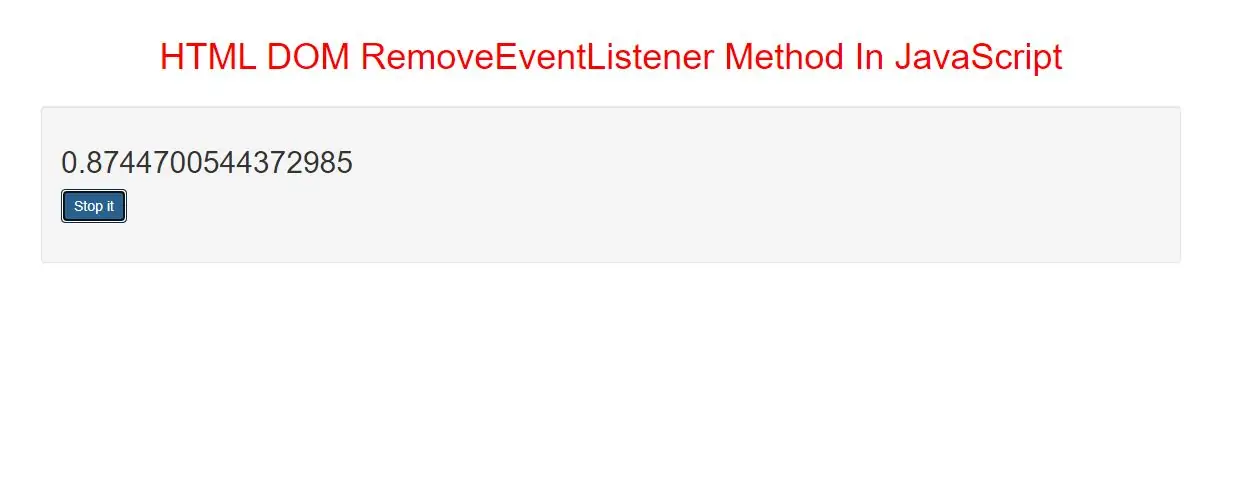
The document.removeEventListener() method removes an event handler that has been attached with the document.addEventListener() method.
Note: To remove event handlers, the function specified with the addEventListener() method must be an external, "named" function, like in the example above (myFunction).
Anonymous functions, like "document.removeEventListener("event", function(){ myScript });" will not work.
Tip: Use the element.addEventListener() and element.removeEventListener() methods to add/remove event handlers to/from a specified element.
To know more about addEventListener() method visit our Bajarangisoft site.
Syntax and Usage
document.removeEventListener(event, function, useCapture)
Parameter Values
Parameter Description
event Required. A String that specifies the name of the event to remove.
Note: Do not use the "on" prefix. For example, use "click" instead of "onclick".
Tip: For a list of all HTML DOM events, look at our complete HTML DOM Event Object Reference.
function Required. Specifies the function to remove.
useCapture Optional. A Boolean value that specifies the event phase to remove the event handler from.
Possible values:
true - Removes the event handler from the capturing phase
false- Default. Removes the event handler from the bubbling phase
Note: If the event handler was attached two times, one with capturing and one bubbling, each must be removed separately.
Example(1)
This document has an onmousemove event handler that displays a random number every time you move your mouse in this document.
<h2 id="demo"></h2>
<button class="btn btn-primary" onclick="removeHandler()">Stop it</button><br><br>
<script>
document.addEventListener("mousemove", addhandler);
function addhandler() {
document.getElementById("demo").innerHTML = Math.random();
}
function removeHandler() {
document.removeEventListener("mousemove", addhandler);
}
</script>
In above example when i click button it will remove the event handler.
Example(2)
The removeEventListener() method is not supported Internet Explorer 8 and earlier versions.</p>
<p>This example demonstrates a solution that will work for all browsers.</p>
<p>This document has an onmousemove event handler attached with the addEventListener() method, that displays a random number every time you move your mouse in this document.
<button onclick="removeHandler()" id="Btn">Stop it</button>
<h2 id="demo"></h2>
<script>
if (document.addEventListener) {
document.addEventListener("mousemove", myFunction);
} else if (document.attachEvent) {
document.attachEvent("onmousemove", myFunction);
}
function myFunction() {
document.getElementById("demo").innerHTML = Math.random();
}
function removeHandler() {
if (document.removeEventListener) {
document.removeEventListener("mousemove", myFunction);
} else if (document.detachEvent) {
document.detachEvent("onmousemove", myFunction);
}
}
</script>
In above example when i click button it will remove the event handler.
Complete code for HTML DOM RemoveEventListener Method In JavaScript
<!DOCTYPE html>
<html>
<head>
<title>HTML DOM RemoveEventListener Method In JavaScript</title>
<meta charset="utf-8">
<meta name="viewport" content="width=device-width, initial-scale=1">
<link rel="stylesheet" href="https://maxcdn.bootstrapcdn.com/bootstrap/3.4.1/css/bootstrap.min.css">
</head>
<style>
h1 {
color: red;
}
</style>
<body>
<div class="container">
<br>
<br>
<div class="text-center">
<h1>HTML DOM RemoveEventListener Method In JavaScript</h1>
</div>
<br>
<div class="well">
<h2 id="demo"></h2>
<button class="btn btn-primary" onclick="removeHandler()">Stop it</button><br><br>
</div>
<br>
</div>
</body>
</html>
<script>
document.addEventListener("mousemove", addhandler);
function addhandler() {
document.getElementById("demo").innerHTML = Math.random();
}
function removeHandler() {
document.removeEventListener("mousemove", addhandler);
}
</script>